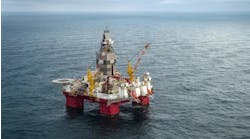As the offshore industry moves into deeper water, the effective reach of pipelines for crude oil transport to transfer facilities or shore is limited by the insulating power of the exterior coatings. It is that insulation which keeps the heat of the produced oil above the cloud point preventing the formation of hydrates, waxes, and asphaltenes, which would diminish the effective flow through the pipeline or stop the flow entirely by plugging the line.
Borealis Group has developed a new form of polypropylene, BA212E - a stiff polypropylene, to address some of the limitations of standard polypropylene coatings.
Solid polypropylene has a density of 900 kg/cu meter and an insulation value of 0.22 W/mK, while standard or reference foam polypropylene has a density of 700 kg/cu meter and an insulation value of 0.17 W/mK. The stiff polypropylene foam improves both the density and insulating values significantly over these standard products with a density of 600 kg/cu meter and an insulation value of 0.15 W/mK.
This is a 31% improvement over standard materials. It is accomplished by creating an improved foam structure through better distribution of smaller bubbles within the polypropylene material, resulting in improved mechanical properties. The BA212E stiff polypropylene foam provides several improvements over standard foam polypropylene:
- Insulates better, allowing a smaller thickness of polypropylene to be used to achieve the same insulating value
- Allows more pipe to be coiled on a reel due to the smaller diameter of the coating
- Saves material in a multi-layer coating also due to the smaller diameter, which saves money
- Smaller diameter saves weight which reduces transport costs for the same length of pipe
- Permits laying pipe in deeper water because of the coating's better compression strength.
These advantages are encouraging a move away from standard polypropylene and foam polypropylene coatings to high bubble density coatings like stiff polypropylene.
Each pipeline application of the coating must be engineered to the offshore field and its water depth. To design the right combination of coatings and thickness, the key values required are the crude temperature, the exterior water temperature, water depth and allowable shutdown periods.
Using these values, it its possible to predict the heat loss along the pipeline so that the temperature of the crude can be maintained above the cloud point for the crude oil produced. For example, at 1,000 meters water depth the same length of pipeline could be insulated with a 60-mm coating of solid standard polypropylene or with 35 mm of foamed stiff polypropylene. The 40% decrease in thickness for the same insulating value is an obvious advantage.
Ringhorne for first use
The first pipeline installation using BA212E stiff polypropylene foam as a coating is at Ringhorne in the Norwegian North Sea. The pipe for that project went into production this May 2001 and will be in place for the production start of the oil field during the third quarter of this year.
The Borealis Group has been producing polypropylene for offshore use for 15 years and is the second largest producer of polyolefins in Europe and the fourth largest worldwide.
For more information contact Cecilia Rydin, Borealis: Tel: +46 303 860 00, Fax: +46 303 812 27, E-mail: [email protected] .



